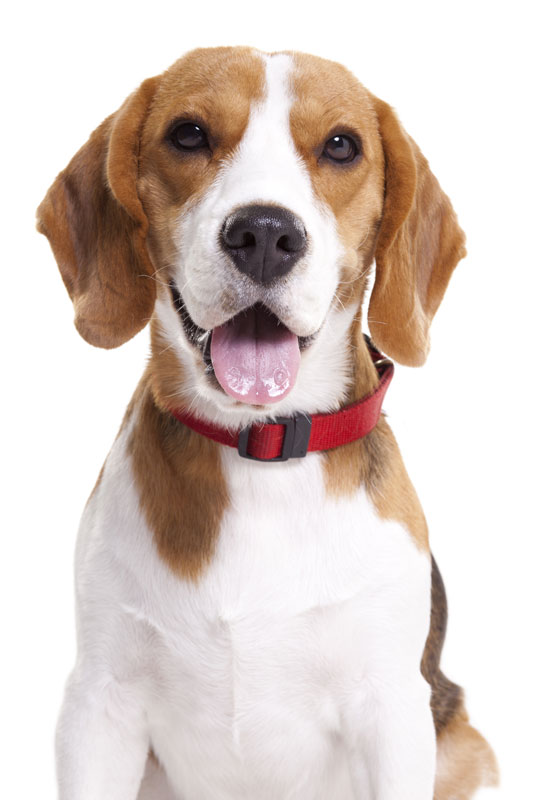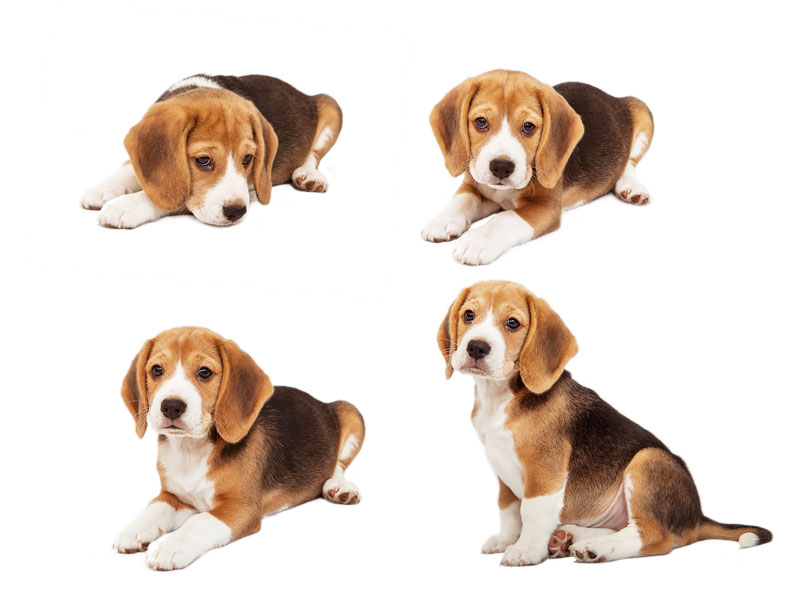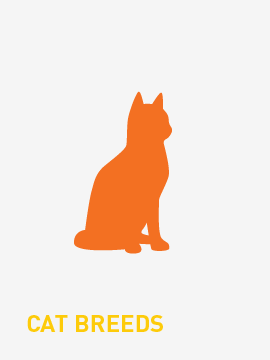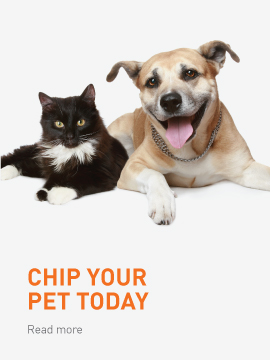The Beagle is a dog breed of small to medium-sized dog. A member of the hound group, it is similar in appearance to the foxhound, but smaller with shorter legs and longer, softer ears. Beagles are scent hounds, developed primarily for Tracking (hunting) hare, rabbit,deer, and other small Game (food). They have a great sense of smell and tracking instinct that sees them employed as detection dogs for prohibited agricultural imports and foodstuffs in quarantine around the world. Beagles are intelligent but single-minded, and popular pets because of their size, even temper, and lack of Dog health#Genetic diseases.Although beagle-type dogs have existed for over 2,000 years, the modern breed was developed in Great Britain around the 1830s from several breeds, including the Talbot, the North Country Beagle, the, and possibly the Harrier.Beagles have been depicted in popular culture since Elizabethan era times in literature and paintings, and more recently in film, television and comic books. Snoopy of the comic strip Peanuts has been promoted as "the world's most famous beagle".
History
Early beagle-type dogs
Dogs of similar size and purpose to the modern Beagle can be traced in Ancient Greece
back to around the 5th century BC. Xenophon, born around 430 BC, in his Treatise on Hunting or Cynegeticus refers to a hound that hunted hares by scent and was followed on foot. Small hounds are mentioned in the Forest Laws of Canute the Great which exempted them from the ordinance which commanded that all dogs capable of running down a Deer should have one foot mutilated. If genuine, these laws would confirm that beagle-type dogs were present in England before 1016, but it is likely the laws were written in the Middle Ages to give a sense of antiquity and tradition to Forest Law. In the 11th century, William I of England brought the Talbot to Britain. The Talbot was a predominantly white, slow, deep-throated, scent hound derived from the St. Hubert Hound which had been developed in the 8th century. At some point the English Talbots were crossed with Greyhounds to give them an extra turn of speed. Long extinct, the Talbot strain probably gave rise to the Southern Hound which, in turn, is thought to be an ancestor of the modern day Beagle.From medieval times, beagle was used as a generic description for the smaller hounds, though these dogs differed considerably from the modern breed. Miniature breeds of beagle-type dogs were known from the times of Edward II of England and Henry VII of England, who both had packs of Glove Beagles, so named since they were small enough to fit on a glove, and Elizabeth I of England kept a breed known as a Pocket Beagle, which stood 20.3cm - 22.9cm at the shoulder. Small enough to fit in a "pocket" or saddlebag, they rode along on the hunt. The larger hounds would run the prey to ground, then the hunters would release the small dogs to continue the chase through underbrush. Elizabeth I referred to the dogs as her singing beagles and often entertained guests at her royal table by letting her Pocket Beagles cavort amid their plates and cups. 19th-century sources refer to these breeds interchangeably and it is possible that the two names refer to the same small variety. In George Jesse's Researches into the History of the British Dog from 1866, the early 17th-century poet and writer Gervase Markham is quoted referring to the Beagle as small enough to sit on a man's hand and to the:
Standards for the Pocket Beagle were drawn up as late as 1901; these genetic lines are now extinct, although modern breeders have attempted to recreate the variety.
Eighteenth century
By the 18th century two breeds had been developed for hunting hare and rabbit: the and the North Country Beagle (or Northern Hound). The Southern Hound, a tall, heavy dog with a square head, and long, soft ears, was common from south of the River Trent and probably closely related to the Talbot. Though slow, it had stamina and an excellent scenting ability. The North Country Beagle, possibly a cross between an offshoot of the Talbot stock and a Greyhound, was bred chiefly in Yorkshire and was common in the northern counties. It was smaller than the Southern Hound, less heavy-set and with a more pointed muzzle. It was faster than its southern counterpart but its scenting abilities were less well developed. As fox hunting became increasingly popular, numbers of both types of hound diminished. The beagle-type dogs were crossed with larger breeds such as Stag Hounds to produce the modern English Foxhound. The beagle-size varieties came close to extinction but some farmers in the South ensured the survival of the prototype breeds by maintaining small rabbit-hunting packs.
Development of the modern breed
Reverend Phillip Honeywood established a Beagle pack in Essex in the 1830s and it is believed that this pack formed the basis for the modern Beagle breed.
Although details of the pack's lineage are not recorded it is thought that North Country Beagles and Southern Hounds were strongly represented; William Youatt suspected that Harrier formed a good majority of the Beagle's bloodline, but the origin of the Harrier is itself obscure. Honeywood's Beagles were small, standing at about 25.4cm at the shoulder, and pure white according to John Mills (writing in The Sportsman's Library in 1845). Albert, Prince Consort and Edward Turnour, 4th Earl Winterton also had Beagle packs around this time, and royal favour no doubt led to some revival of interest in the breed, but Honeywood's pack was regarded as the finest of the three.Although credited with the development of the modern breed, Honeywood concentrated on producing dogs for hunting and it was left to Thomas Johnson to refine the breeding to produce dogs that were both attractive and capable hunters. Two strains were developed: the rough- and smooth-coated varieties. The rough-coated Beagle survived until the beginning of the 20th century, and there were even records of one making an appearance at a dog show as late as 1969, but this variety is now extinct, having probably been absorbed into the standard Beagle bloodline.In the 1840s, a standard Beagle type was beginning to develop; the distinction between the North Country Beagle and Southern Hound had been lost, but there was still a large variation in size, character, and reliability among the emerging packs. In 1856, "Stonehenge" (the pseudonym of John Henry Walsh), writing in the Manual of British Rural Sports, was still dividing Beagles into four varieties: the medium Beagle; the dwarf or lapdog Beagle; the fox Beagle (a smaller, slower version of the Foxhound); and the rough-coated or terrier Beagle, which he classified as a cross between any of the other varieties and one of the Scottish terrier breeds. Stonehenge also gives the start of a standard description:By 1887 the threat of extinction was on the wane: there were 18 Beagle packs in England. The Beagle Club was formed in 1890 and the first standard drawn up at the same time. The following year the Association of Masters of Harriers and Beagles was formed. Both organisations aimed to further the best interests of the breed, and both were keen to produce a standard type of Beagle. By 1902, the number of packs had risen to 44. The Beagle was accepted as a breed by the American Kennel Club (AKC) in 1885. In the 20th century the breed has spread worldwide.
Popularity
On its formation, the Association of Masters of Harriers and Beagles took over the running of a regular show at Peterborough that had started in 1889, and the Beagle Club in the UK held its first show in 1896.As purebred dogs, Beagles have always been more popular in the United States and Canada than in their native country England. The National Beagle Club of America was formed in 1888 and by 1901 a Beagle had won a Best in Show title. As in the UK, activity during World War I was minimal, but the breed showed a much stronger revival in the U.S. when hostilities ceased. In 1928 it won a number of prizes at the Westminster Kennel Club's show and by 1939 a Beagle – Champion Meadowlark Draughtsman – had captured the title of top-winning American-bred dog for the year. On 12 February 2008, a Beagle, K-Run's Park Me In First, won the Best In Show category at the Westminster Kennel Club show for the first time in the competition's history. In North America they have been consistently in the top-ten most-popular breeds for over 30 years. From 1953 to 1959 the Beagle was ranked No. 1 on the list of the American Kennel Club's registered breeds; in 2005 and 2006 it ranked 5th out of the 155 breeds registered. In the UK they are not quite so popular, placing 28th and 30th in the rankings of registrations with the Kennel Club in 2005 and 2006 respectively. In the United States the Beagle ranked 4th most popular breed in 2012 and 2013, behind the Labrador Retriever (#1), German Shepherd (#2) and Golden Retriever (#3) breeds.
Name
According to the Oxford English Dictionary, the first mention of the beagle by name in English literature dates from ca. 1475 in the Esquire of Low Degree. The origin of the word "beagle" is uncertain, although it has been suggested that the word derives from the French begueule (meaning "open throat" from bayer "open wide" and gueule "mouth") or from an Old English language, French or the Goidelic languages word beag, meaning "little." Other possibilities include the French beugler (meaning "to bellow") and the German begele (meaning "to scold").It is not known why the black and tan Kerry Beagle, present in Ireland since Celtic times, has the beagle description, since at 55.9cm - 61cm it is significantly taller than the modern day Beagle, and in earlier times was even larger. Some writers suggest that the Beagle's scenting ability may have come from cross-breeding earlier strains with the Kerry Beagle. Originally used for hunting stags, it is today used for hare and drag hunting.
Health
The typical longevity of Beagles is 12–15 years, which is a common lifespan for dogs of their size.Beagles may be prone to epilepsy, but this can often be controlled with medication. Hypothyroidism and a number of types of dwarfism occur in Beagles. Two conditions in particular are unique to the breed: "Funny Puppy", in which the puppy is slow to develop and eventually develops weak legs, a crooked back and although normally healthy, is prone to a range of illnesses; Hip dysplasia (canine), common in Harriers and in some larger breeds, is rarely considered a problem in Beagles. Beagles are considered a chondrodystrophy breed, meaning that they are prone to types of disk diseases.In rare cases, Beagles may develop immune mediated polygenic arthritis (where the immune system attacks the joints) even at a young age. The symptoms can sometimes be relieved by Corticosteroid#Uses treatments.Beagles may exhibit a behaviour known as reverse sneezing, in which they sound as if they are choking or gasping for breath, but are actually drawing air in through the mouth and nose. The exact cause of this behaviour is not known, but it is not harmful to the dog.
In popular culture
Beagles have been featured across a wide range of media. References to the dog appear before the 19th century in works by such writers as William Shakespeare, John Webster, John Dryden, Thomas Tickell, Henry Fielding and William Cowper, and in Alexander Pope's translation of Homer's Iliad. Beagles appeared in funny animal comic strips and animated cartoons from the 1950s with the Peanuts character Snoopy, billed as "the world's most famous Beagle",c. The Harts posed the following question to a panel of 96 experts, half of which were veterinary surgeons and the other half dog obedience trial judges:d. The specific references in each of the author's works are as follows:Shakespeare: "Sir Toby Belch: She's a beagle, true-bred, and one that adores me: what o' that?" Twelfth Night (c.1600) Act II Scene III Webster: "Mistress Tenterhook: You are a sweet beagle" Westward Ho (play) (1607) Act III Scene IV:2Dryden: "The rest in shape a beagle's whelp throughout, With broader forehead and a sharper snout" The Cock and the Fox, and again: "About her feet were little beagles seen" in Palamon and Arcite both from Fables, Ancient and Modern (1700)Tickell: "Here let me trace beneath the purpled morn, The deep-mouth'd beagle, and the sprightly horn" To a Lady before Marriage (published posthumously in 1749)Fielding: "'What the devil would you have me do?' cries the Squire, turning to Blifil, 'I can no more turn her, than a beagle can turn an old hare.'" The History of Tom Jones, a Foundling (1749) Chapter 7.Cowper: "For persevering chase and headlong leaps, True beagle as the staunchest hound he keeps" The Progress of Error (1782)Pope: "Thus on a roe the well-breath'd beagle flies, And rends his hide fresh-bleeding with the dart" The Iliad of Homer (1715–20) Book XV:697–8











